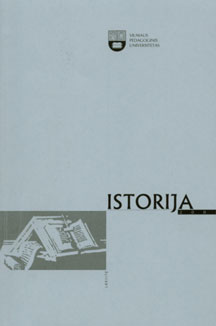Lietuvos gyvenvietės ir kaimai 1976–2006 m.: demografinis tyrimas
Lithuania’s Rural Settlements and Villages in 1976–2006: Demographic Research
Author(s): Jonas MardosaSubject(s): History
Published by: Vytauto Didžiojo Universitetas
Keywords: settlements; villages; individual farms; farmsteads; type of settlement; the number of residents; demography.
Summary/Abstract: The article reviews the essential changes in the Lithuanian rural settlements and statistical data of its inhabitants at the turn of the 20th-21st centuries. Research, carried out in Anykščiai district in 1976-2006, investigated the structure of villages and rural settlements as well as the number of their residents. On the basis of different groups of villages, the data collected allowed to further investigate demographical changes in rural areas and define the dynamics of the number of rural settlements and tendencies of their development in the period of 30 years. Further, the data amassed in the district of Anykščiai was compared with the data of similar researches carried out in the districts of Alytus and Vilkaviškis with the aim to ascertain to what extent the tendencies noticeable in Anykščiai district are characteristic of entire Lithuania. This way, the tendencies of the reconstruction of the rural settlements’ system during the above mentioned period were fixed. It was established that even the 21st century settlements followed the model of the Soviet farming system. The settlement system formed in the first half of the 20th century is defined as substratum in the article. The main direction of the demographical processes in Lithuania’s rural areas points to the increasing concentration of people in the urbanized settlements which comprise the superstratic layer of contemporary settlements. The data also proves that the model of rural settlements, following the tradition of the Soviet period and consisting of central and subsidiary farms, was the prevailing one. However, this tendency is accompanied by the other one, i. e. the decrease in rural population. People’s migration results in the increasing number of small settlements. Traditional villages of average size, from 50 to 100 inhabitants, lost a certain number of their residents thus increasing the number of small rural settlements; in addition, the number of deserted villages also increased. The essential tendencies of rural development and the dynamics of the population number of these settlements are characteristic of all Lithuania’s settlements. The rural policy of the Soviet period, which aimed at intensive land-reclamation and destruction of individual farms, conditioned greater concentration of inhabitants in larger settlements and a constantly increasing number of smaller rural settlements. The data from the districts of Alytus and Vilkaviškis shows that rural development tendencies and intensity were influenced by historical legacy of certain regions, economic and social trends as well as the directions of the Soviet policy. The essential tendency of these demographic processes is the increasing number of inhabitants in small villages...
Journal: Istorija. Lietuvos aukštųjų mokyklų mokslo darbai
- Issue Year: 72/2008
- Issue No: 4
- Page Range: 62-70
- Page Count: 9
- Language: Lithuanian

